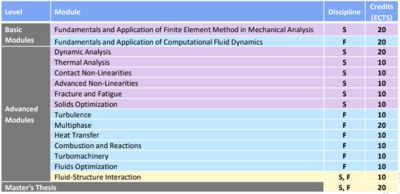-
-
Access Free Student Software
Ansys empowers the next generation of engineers
Students get free access to world-class simulation software.
-
Connect with Ansys Now!
Design your future
Connect with Ansys to explore how simulation can power your next breakthrough.
Countries & Regions
Free Trials
Products & Services
Learn
About
Back
Products & Services
Back
Learn
Ansys empowers the next generation of engineers
Students get free access to world-class simulation software.
Back
About
Design your future
Connect with Ansys to explore how simulation can power your next breakthrough.
Free Trials
ANSYS BLOG
June 18, 2020
Enroll in an Online Numerical Simulation Master’s Degree that Teaches Ansys Software [Updated for 2020]
Companies need engineers who are trained to use simulation software. However, many engineers are graduating from universities without an understanding of numerical simulation. As for those who do get a taste of numerical methods, typically they only learn the theoretical side without touching any commercial simulation software.
“That is why we started working with the Technical University of Madrid (UPM),” said Mariano Morales, application engineering manager at Ansys. “Industry and simulation technology move faster than the academic world. Our customers are asking for engineers with specific simulation competencies. Engineers need to be more innovative to develop better, more complex products. That takes simulation.”
Theoretical knowledge of simulation is great for those needing to develop their own numerical methods software. It also helps engineers better understand their own simulation analysis — avoiding garbage-in, garbage-out.
“But if this knowledge doesn’t connect to any of the major commercial tools then how can you be an asset to a corporation?” asks Morales, “The master’s degree covers this gap: a strong understanding of the methods used in numerical simulation software, with practical applications and best practices to solve real world problems.”
Engineers who enroll in the degree will gain an understanding of numerical methods and how to use Ansys Pervasive Engineering Simulation software.
What Sets the Master’s Degree on Numerical Simulation Apart from Other Simulation Courses?
Ansys supplies and supports other training courses. For instance, there is a free massive open online course (MOOC) from Cornell University that teaches engineering simulation. Additionally, Ansys offers a training center that teaches you how to use the software.
“These formats focus on how to use Ansys software,” clarifies Morales, “The UPM online master’s is a formal post graduate degree that teaches how to use the software in a much deeper way, but also what’s under the hood.”
The UPM online master’s involves rigorous simulation training for working professionals.
Though this course is online, it’s rigorous, involving:
- Interactions with professors
- Interactions with students
- Online forums
- Readings
- Assignments
- Videos
The master’s also culminates in a thesis that involves teamwork, live sessions and meetings between students and professors. Students pick the topic for their master’s thesis, usually a practical area, a research topic or an industrial application.
Morales says, “This might sound like a lot of work, and it is, but UPM understands that most of its simulation students are recent graduates and working professionals with tight schedules. As a result, the master’s degree offers highly flexible hours. The content is modular, and students can take as little as one class per semester. They can even take semester-long breaks if needed. Since the program is online, it is available to anyone globally.”
How the Master’s Degree on Numerical Simulation Is Structured
The UPM online master’s is structured within a virtual classroom. Students first learn the basics, like physics and numerical methods. Then, the theory is translated into the Ansys’ applications and put into practice by a set of tutorials.
“We use real hands-on simulations and case studies,” says Morales. “Students use real geometries and connect the theory to the practical knowledge we provide. We try to make the program industry-agnostic. We believe the value is getting knowledge of simulation, in general, and talking about the application areas where you can find that simulation useful.”
The master’s covers the use of various software including:
Students also gain access to a full Ansys license through the university. It’s the same software used in industry every day — this isn’t a student software package.
Students need to complete 70 credits worth of modules including a basics module and
a master’s thesis. Course modules are divided into a mechanical and fluid stream.
The courses are divided into mechanical and fluid streams. Once students have taken a course module that covers the basics of mechanics or fluid dynamics, they can take more advanced course modules within that stream. This way, engineers can shape the master’s into what they need it to be.
Students will need to complete a total of 70 credits worth of modules including their 20-credit basic module and 20-credit master’s thesis. That leaves 30 credits for the student to dedicate to the advanced modules of their choice.
Depending on the student’s pace, they can complete the masters within one to six semesters. Students can take semester long breaks or reduce the degree (to a specialist or expert degree) by taking fewer modules.
For an overview of this degree, read: Online Master's Degree — Numerical Simulation in Engineering with Ansys. Or watch the webinar below:
Webinar overview of a master's degree in numerical simulation that uses Ansys Pervasive Engineering Simulation software.


